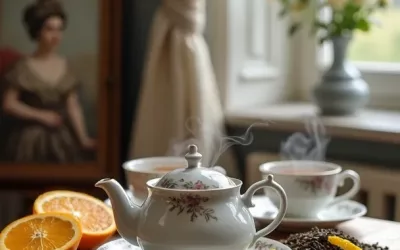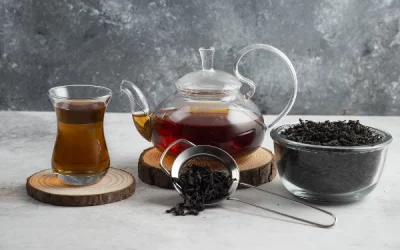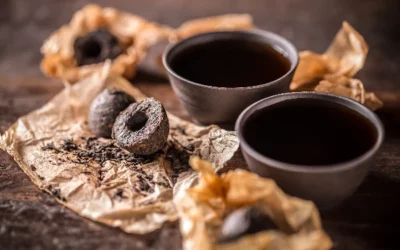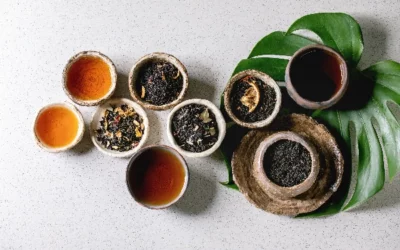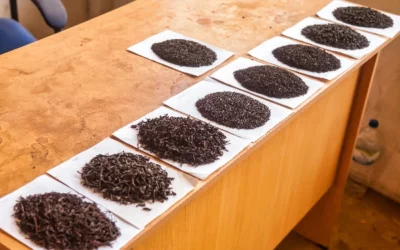Have you ever wondered why Lapsang Souchong tea is often described as a ‘smoky delight’? This unique black tea, originating from China, captivates enthusiasts with its rich flavour and intriguing aroma. As an authentic choice among black teas, its distinct characteristics and numerous health benefits make it a worthy addition to any tea lover’s collection. In this article, we’ll explore everything you need to know about Lapsang Souchong, from its production methods to ideal brewing techniques and perfect food pairings. Let’s embark on a fragrant journey into the world of Lapsang Souchong tea!
Table of Content
- What is Lapsang Souchong tea?
- How is Lapsang Souchong tea made?
- What does Lapsang Souchong tea taste like?
- How does the smoky flavour develop during production?
- What are the common tasting notes found in Lapsang Souchong?
- How does the brewing method affect the taste?
- Where can I buy Lapsang Souchong tea?
- What are the best online retailers for Lapsang Souchong tea?
- How can I identify high-quality Lapsang Souchong tea?
- Are there any local brands that offer authentic Lapsang Souchong?
- How do I brew Lapsang Souchong tea?
- What are the health benefits of Lapsang Souchong tea?
- What food pairs well with Lapsang Souchong tea?
- What savoury dishes enhance the smoky flavour?
- Which desserts are best paired with Lapsang Souchong?
- How does cheese pairing work with this tea?
- What are the myths surrounding Lapsang Souchong tea?
- What are some common myths about Lapsang Souchong?
- How can one differentiate between real and fake Lapsang Souchong?
- Are there any exaggerated health claims regarding this tea?
- Conclusion
What is Lapsang Souchong tea?
Lapsang Souchong tea, also known as “Zheng Shan Xiao Zhong,” is a distinctive black tea that originates from the Wuyi Mountains in China’s Fujian province. This unique tea is renowned for its smoky flavour, which comes from the traditional method of drying the tea leaves over pinewood fires. This method infuses the leaves with a rich, smoky aroma and a slightly sweet taste, setting it apart from other black teas.
The production process of Lapsang Souchong includes several steps, such as withering, rolling, oxidation, and smoking. By drying the leaves over pinewood fires, producers create the tea’s characteristic smokiness. This meticulous process ensures high quality and imparts a range of health benefits, including antioxidants and potential stress relief.
The tea holds cultural significance in China and has become a favourite among tea enthusiasts worldwide. Let’s delve deeper into the key attributes and benefits of Lapsang Souchong tea.
What are the key characteristics of Lapsang Souchong tea?
Lapsang Souchong tea stands out due to several distinct characteristics:
- Smoky Aroma: The leaves absorb the scent of pinewood smoke, giving the tea its signature smoky aroma.
- Smooth Texture: The tea has a smooth, almost silky mouthfeel that makes each sip enjoyable.
- Sweet Undertones: Behind the smoky flavour, you will detect subtle sweet, fruity undertones.
- Dark Colour: The tea brews to a deep, dark amber colour, indicative of its robust flavour profile.
- Long-lasting Flavour: The aftertaste lingers, allowing tea drinkers to savour the unique taste long after their last sip.
The intricate production process and the use of pinewood fires are what make these characteristics possible, giving Lapsang Souchong its distinctive identity.
How does Lapsang Souchong differ from other black teas?
Lapsang Souchong differs from other black teas in several ways:
- Production Method: Unlike most black teas, Lapsang Souchong is dried over pinewood fires, which imparts its smoky flavour.
- Flavour Profile: While many black teas have floral or malty notes, Lapsang Souchong has a prominent smoky taste.
- Cultural Significance: This tea has a rich history and cultural significance in China, especially in the Fujian province.
- Leaf Quality: The leaves used for Lapsang Souchong are often larger and more mature than those used for other black teas.
- Oxidation Process: The oxidation process for Lapsang Souchong is carefully controlled to balance smokiness with natural tea flavours.
These differences make Lapsang Souchong a unique choice for tea enthusiasts, offering a completely different experience from other black teas.
What health benefits are associated with Lapsang Souchong tea?
Lapsang Souchong tea is not just about its distinctive flavour; it also offers various health benefits:
- Rich in Antioxidants: The tea contains antioxidants, which can help neutralise harmful free radicals in the body.
- Stress Relief: The act of drinking tea itself can be calming, but the specific compounds in Lapsang Souchong may also help reduce stress.
- Improved Digestion: The tea can aid in digestion, making it a good choice after heavy meals.
- Boosts Immune System: The antioxidants and other compounds in the tea can help boost your immune system.
- Anti-inflammatory Properties: Some studies suggest that black teas can help reduce inflammation in the body.
Drinking Lapsang Souchong can be not only a delightful sensory experience but also a beneficial addition to your daily routine.
Lapsang Souchong tea has a fascinating history. The tea is said to have been discovered during the Qing Dynasty when a troop of soldiers occupied a tea factory. Pressed for time, the workers dried the leaves over pinewood fires, which resulted in the smoky flavour we now associate with Lapsang Souchong. This method was initially a necessity but later became a defining characteristic of the tea.
How is Lapsang Souchong tea made?
Lapsang Souchong tea, often simply called “lapsang tea,” is known for its distinctive smoky flavour. This unique taste comes from a traditional production process that includes smoking the tea leaves over pinewood fires. Here’s a breakdown of how this famous black tea is made.
Understanding the production process helps you appreciate the time, effort, and expertise involved. Below is a table summarising the key steps, their duration, and how each step affects the flavour of the tea.
| Production Step | Duration | Impact on Flavour |
|---|---|---|
| Withering | 10-12 hours | Reduces moisture, concentrates initial flavours |
| Rolling | 30 minutes | Releases enzymes, sets the stage for oxidation |
| Oxidation | 3-6 hours | Develops the tea’s robust body and aroma |
| Smoking | 1-2 hours | Adds the characteristic smoky taste |
| Drying | 1-2 hours | Stops oxidation, locks in flavours |
| Sorting and Grading | 1-2 hours | Ensures quality by removing inferior leaves |
| Packaging | Variable | Preserves freshness and flavour profiles |
To use this table:
- Refer to the ‘Production Step’ column for each key phase in making Lapsang Souchong tea.
- Check the ‘Duration’ column to understand how long each step typically takes.
- Look at the ‘Impact on Flavour’ column to see how each step influences the tea’s final taste.
What are the key steps in making Lapsang Souchong tea?
To dive deeper, let’s explore these key steps in more detail. The production process is a meticulous journey that enhances the tea’s unique characteristics.
- Withering: Freshly plucked tea leaves are spread out to wither, reducing moisture content and intensifying initial flavours.
- Rolling: The withered leaves are rolled to break down their cell walls, releasing enzymes that prepare them for oxidation.
- Oxidation: The leaves are exposed to air, allowing them to oxidise. This step is crucial for developing the tea’s strong, bold body and aroma.
- Smoking: After oxidation, the leaves are smoked over pinewood fires, infusing them with a smoky character.
- Drying: The smoked leaves are further dried to cease oxidation, which locks in the flavours.
- Sorting and Grading: The dried leaves are sorted to remove any inferior quality leaves, ensuring a consistent and high-quality product.
- Packaging: Finally, the leaves are packaged to preserve their freshness and unique flavour profiles.
How does each step affect the flavour of Lapsang Souchong tea?
Understanding how each step impacts the flavour can help you appreciate the complexity and artistry involved in producing this unique tea.
- Withering: As the leaves lose moisture, their initial flavours become more concentrated.
- Rolling: Breaking down the cell walls releases enzymes, setting the stage for the oxidation process.
- Oxidation: This step is essential for developing the tea’s robust body and rich aroma. The level of oxidation can significantly influence the final taste.
- Smoking: This is the signature step for Lapsang Souchong tea, imparting its characteristic smoky flavour.
- Drying: By stopping the oxidation process, drying helps to lock in the flavours developed during the previous steps.
- Sorting and Grading: Ensuring only high-quality leaves make it to the final product guarantees a consistent and enjoyable flavour profile.
- Packaging: Proper packaging preserves the tea’s freshness and ensures that the unique flavours are maintained until you brew your cup.
The traditional production of Lapsang Souchong tea is quite fascinating. This tea is said to have originated in the Wuyi Mountains of China’s Fujian Province. Legend has it that during the Qing Dynasty, a group of tea farmers needed to expedite the drying process to meet tight deadlines. They chose to dry their tea over pinewood fires, which resulted in an unprecedented smoky flavour that surprisingly became highly sought after.
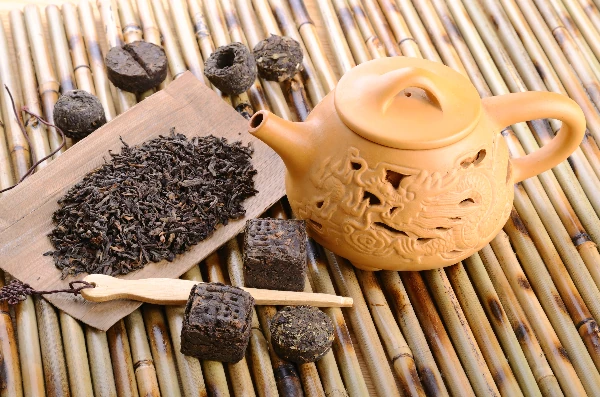
What does Lapsang Souchong tea taste like?
Let’s get to the crux of the matter. When you sip Lapsang Souchong tea, you’re in for a sensory ride. This black tea, with its roots in China’s Fujian province, offers a flavour profile that’s like no other.
Picture this: you’re having a bonfire – the comforting, rustic scent fills the air. Now, imagine sipping that sensation. Yep, that’s Lapsang Souchong for you. It’s all about smoky notes, a hint of sweetness, an aroma that could charm the socks off a lumberjack, a robust mouthfeel, and an aftertaste that lingers longer than your in-laws at Christmas.
How does the smoky flavour develop during production?
The magic begins with the leaves. These aren’t just any leaves; they’re hand-picked, which is a fancy way of saying someone’s gone up a hill to get them. Once the leaves are plucked, they’re withered over pinewood fires. This fiery business is where the tea starts to develop its iconic smoky flavour. It’s like giving the leaves a spa day, but instead of hot stones, they get a pinewood sauna.
- Withering: The leaves are spread out and left to dry, typically over pinewood fires.
- Rolling: Once withered, they’re rolled to break down their cellular structure.
- Oxidising: This step lets the leaves dance with oxygen, changing their chemistry.
- Smoking: Here is where our smoky hero is born. The leaves are smoked over pinewood fires.
- Drying: Finally, they are fully dried to lock in all those delicious smoky elements.
And there you have it – leaf magic, turned smoky goodness.
What are the common tasting notes found in Lapsang Souchong?
Now that we’ve covered the production, let’s chat about what you’ll actually taste when you pour yourself a steamy cup of Lapsang Souchong. This tea is not shy on the palate.
- Smoky: Imagine licking a campfire in the best possible way.
- Sweet: A subtle sweetness balances out the smoke, like finding a marshmallow in your barbecue.
- Earthy: It’s got the comforting richness of damp forest floor.
- Pine resin: A distinct note that makes you think of pine trees swaying in the wind.
- Malt: There’s a grainy, biscuity quality that gives it depth.
These notes make the tea a complex and multi-dimensional sipper. You might even find yourself pausing to ponder life’s great mysteries between gulps.
How does the brewing method affect the taste?
Brew it wrong, and you might as well be sipping on charcoal water. But do it right, and you’ll hit that sweet spot of smoky perfection. The brewing method plays a pivotal role in teasing out the flavours of Lapsang Souchong.
- Water temperature: Aim for around 90°C. Boiling water will scorch the tea, but cooler water won’t extract enough flavour.
- Steeping time: Keep it tight at 3-4 minutes. Too short, and it’ll be weak; too long, and you’ll be overwhelmed by bitterness.
- Quantity: About one teaspoon per cup. Overloading your teapot can lead to an overly intense brew.
- Teapot material: Clay teapots hold heat better and can enhance the brewing process.
- Freshness: Use fresh, filtered water for the best taste. Stale water equals stale flavour.
Think of brewing Lapsang Souchong like serenading a wild animal; handle it gently and with care, and you’ll be rewarded.
Around 1662, Catherine of Braganza, the Portuguese princess, married King Charles II of England. Along with her dowry came tea – the exotic beverage that was to become the English staple. Though there’s no record of her fondness for Lapsang Souchong specifically, it can be fun to imagine her introducing this smoky ambrosia to the court.
Picture courtiers, more accustomed to ale and mead, cautiously raising their cups, only to be wooed by the rich, mysterious flavour of a well-prepared Lapsang. It’s a charming thought, and gives a small glimpse into how tea began to weave itself into the very fabric of British culture.
Where can I buy Lapsang Souchong tea?
If you’re on the hunt for lapsang tea, you’ve got some fantastic options. Whether you’re craving that smoky flavour from a local shop or an international supplier, there’s a way to quench your thirst for this unique brew. But let’s dive into where you can find the best Lapsang Souchong tea without feeling like you’re searching for a needle in a haystack.
First up, online retailers are your go-to. They’re a real lifesaver, especially when you’re in your pyjamas and can’t be bothered stepping out. Specialty tea shops are another great option. They tend to carry higher-quality selections, and the staff often know their stuff. Then there are local markets—always a gamble, but sometimes you get lucky with a hidden gem. Lastly, international suppliers, if you’re feeling fancy and don’t mind waiting for shipping.
What are the best online retailers for Lapsang Souchong tea?
Not all online retailers are created equal, so it’s essential to know where to look for the crème de la crème of Lapsang Souchong.
- Teavivre: A popular choice among tea buffs. They offer a wide range of authentic Chinese teas.
- Adagio Teas: An extensive selection of teas and an excellent customer review system to boot.
- Harney & Sons: Known for high-quality gourmet teas, they also have a decent selection of Lapsang Souchong.
- Amazon: Yes, the giant marketplace has got everything under the sun, including some decent lapsang tea options.
- David’s Tea: Known for their eclectic blends, they also carry some nice lapsangs.
Online shopping can be a mixed bag, so be sure to read reviews. A little bit of sleuthing can save you from a teapot full of disappointment.
How can I identify high-quality Lapsang Souchong tea?
Let’s face it: the more you know about how to spot quality, the less likely you are to end up with a dud. Here’s what to look out for:
- Origin: Traditional Lapsang Souchong hails from the Wuyi region in China. Check the product description.
- Leaves: Whole leaves are your friend. Avoid broken or powdered leaves, which point to inferior quality.
- Smell: That signature smoky aroma should be robust but not overwhelming. If it smells like a campfire gone wrong, steer clear.
- Taste: This one is subjective, but a good Lapsang Souchong should have a balanced smoky and sweet flavour.
- Price: You often get what you pay for. Be wary of prices that seem too good to be true.
Arming yourself with this knowledge will make it easier to find something that’s truly worth sipping on.
Are there any local brands that offer authentic Lapsang Souchong?
Sometimes, staying within your own borders can yield some fantastic results. Here’s where you can keep your eyes peeled:
- Whittard of Chelsea (UK): A reputable retailer with a good selection of teas, including Lapsang Souchong.
- The Tea Makers of London (UK): They offer a variety of teas, and their Lapsang Souchong is well-reviewed.
- Yunnan Sourcing (China-based but offers international shipping): Authentic and high-quality Chinese teas.
- Fortnum & Mason (UK): Known for luxury teas, you can generally trust their quality.
- Mighty Leaf Tea (US): They’ve got a decent selection of artisanal teas, including some delicious Lapsang Souchong.
Scouting for local brands can often pay dividends, especially if those brands are dedicated to quality.
How do I brew Lapsang Souchong tea?
So, you’ve got your hands on some Lapsang Souchong tea. Well done, you’ve officially joined the elite club of tea drinkers! But before you dive in, let’s talk about the best way to brew this smoky wonder. Bear in mind that there’s a method to this madness—get it wrong, and you might end up with something resembling char-grilled water instead of a beautiful, aromatic cup of tea.
When brewing Lapsang Souchong, the game is all about water temperature, steeping time, tea-to-water ratio, and the type of teapot you’re using. Buckle up, because you’re about to become a certified Lapsang tea master.
What is the ideal water temperature for brewing?
First things first: the water temperature. For brewing Lapsang Souchong, you’ll want to aim for around 95°C (203°F). Yeah, this isn’t boiling water. Scalding your tea is a rookie mistake. You’re not trying to disintegrate the leaves but to release their smoky goodness.
- Optimal Temperature: 95°C (203°F)
- Avoid Boiling Water: It’s too harsh for delicate tea leaves.
- Precision Matter: Invest in a kettle with a temperature gauge if you’re serious.
- Let it Cool Briefly: Boil the water, then let it sit for about 30 seconds.
- Enhance Flavour: This temperature helps extract the nuances without bitterness.
You’ve got the hot (but not too hot) water sorted, great! Let’s move on to the next step: steeping time.
How long should I steep the tea?
The steeping time is where many go astray. Too long, and you’ve got yourself a bitter brew. Too short, and you’re drinking flavoured water. For Lapsang Souchong, a good rule of thumb is about 3-4 minutes.
- Steeping Time: 3-4 minutes
- Strength Control: Go for 5 minutes if you like it strong, but risk bitterness.
- Balanced Brew: 3.5 minutes is the sweet spot.
- First Steep: Gets the best flavours.
- Second Steep: You can even reuse the leaves for a milder, second cup.
Nail the timing and you’re halfway to a perfect cup. But, what teapot should you actually be using?
What teapots are best for brewing Lapsang Souchong?
The type of teapot you use can make a significant difference. Lapsang Souchong is a unique creature, and it prefers certain homes over others. Traditionalists often swear by clay teapots, particularly Yixing pots, which absorb the tea’s flavour and create a richer experience over time. Glass teapots, however, let you watch the dance of the tea leaves, adding to the ritual.
- Clay Teapot: Yixing pots are fantastic for absorbing flavours.
- Glass Teapot: Great for visually enjoying the infusion.
- Porcelain Teapot: Neutral material that won’t affect taste.
- Cast Iron: Excellent heat retention but can be heavy.
- Personal Preferene: At the end of the day, choose what suits your style.
Whichever you choose, just make sure it adds to the experience. An awesome teapot can turn brewing tea into an art form.
Throwing it back to Ancient China, there’s a tale about how Lapsang Souchong came to be. During the Qing Dynasty, a troop of soldiers passed through a village in the Wuyi Mountains.
Desperate to find a quick way to dry their tea leaves, the villagers smoked them over pinewood fires. This hasty improvisation gave birth to the now-renowned Lapsang Souchong. Little did they know, their haste created a smoky, robust tea that would be cherished centuries later.
So, there you have it. A little temperature precision, some patience in steeping, and a touch of teapot choice, and you’re on your way to brewing the perfect cup of Lapsang Souchong. Enjoy!
What are the health benefits of Lapsang Souchong tea?
Well, well, well, if you’re a tea aficionado and haven’t given Lapsang Souchong a whirl, you’re missing out on not merely an enchanting flavour profile, but also a host of health benefits. This smoky black brew from the Wuyi region of China has more to offer than just its unique taste. Let’s dive into the nitty-gritty of this iconic tea and see how it can boost your health game.
Let’s cut the fluff and go straight to the point. Lapsang Souchong tea is like the Swiss Army knife of teas, offering several health benefits. It’s packed with antioxidants, aids in digestion, provides a calming effect, and can even support weight loss. Intrigued? You should be! Let’s delve into these aspects a bit more.
How do antioxidants in Lapsang Souchong tea benefit health?
Ah, antioxidants. The little warriors we hear about all the time. Lapsang Souchong tea is brimming with these good guys. They combat free radicals in your body, which are unstable atoms that can cause havoc if left unchecked.
- Reduce oxidative stress, keeping your cells in tip-top shape.
- Lower inflammation, which is good news for your joints and overall health.
- Support heart health by improving blood vessel function.
- Boost your immune system, making you less likely to catch every sniffle.
- Improve skin health, keeping you looking fresh and youthful.
When you sip on this smoky wonder, you’re not just enjoying a delectable cup of tea; you’re giving your body a fighting chance to stay healthy and vibrant. So make sure not to skimp on those antioxidants!
Can Lapsang Souchong aid in digestion?
Ever felt like your stomach has waged war against you after overeating? Lapsang Souchong might just be your peacemaker. This tea is renowned for its ability to support digestion.
- Relieve nausea, making it ideal after a heavy or greasy meal.
- Soothe the stomach lining, which comes in handy if you’re prone to gastritis.
- Stimulate digestive juices, aiding your body to break down food more efficiently.
- Help in reducing bloating and gas – no one enjoys feeling like a balloon.
- Improve bowel movements, keeping things moving smoothly.
Next time you’ve had one too many slices of pizza, remember that a cup of this smoky nectar can help ease those digestive woes. Your stomach will thank you.
Is there any evidence supporting weight loss benefits?
Now, here’s the million-pound question. Can Lapsang Souchong help you shed those extra pounds? While it might not be a magic bullet, there is some evidence that suggests it can lend a hand.
- Boost metabolism, helping you burn calories more efficiently.
- Suppress appetite, keeping those snack cravings in check.
- Increase energy expenditure, which can aid in overall fat loss.
- Support fat oxidation, which means it helps your body break down fat.
- Aid in stabilising blood sugar, which can deter over-eating and cravings.
So, you see, while Lapsang Souchong won’t replace good ol’ exercise and a balanced diet, it can certainly act as a supportive ally in your weight loss journey. Fancy that!
Lapsang Souchong isn’t just a tea; it’s an experience. Smoky, robust, and multi-layered, much like the history behind it. In the 17th century, during the Qing Dynasty, the censorship and suppression of certain crops forced farmers in the Wuyi region to preserve their tea leaves differently.
They smoked the leaves over pinewood fires to expedite drying – hence the distinct taste we love today. Little did they know, they were crafting a beverage that tea enthusiasts around the globe would come to revere, not to mention one that brings a multitude of health benefits. Enjoy your cup, and know you’re tinkering with a bit of history.
What food pairs well with Lapsang Souchong tea?
Let’s spill the tea on what exactly pairs well with Lapsang Souchong. This robust black tea, with its distinctive smoky essence, isn’t for the faint of heart. But once you get past its bold character, it becomes the perfect companion for various foods, adding a new dimension to each bite.
Pairing Lapsang Souchong isn’t just about throwing together random foods and hoping for the best. It involves thoughtful choices for dishes that either complement or contrast its smoky flavour. We’re diving into savoury dishes, sweet treats, cheese pairings, and regional cuisines to find those perfect matches.
What savoury dishes enhance the smoky flavour?
Let’s talk savoury. Lapsang Souchong’s smoky flavour makes it a natural partner for certain savoury dishes. Whether you’re a carnivore or a fan of plant-based delicacies, there’s something for everyone.
- Grilled meats: Think along the lines of BBQ ribs or steak. The smoky tea enhances the charred, meaty goodness.
- Roasted vegetables: Carrots, bell peppers, or aubergines roasted to perfection taste extraordinary when paired with this tea.
- Smoked salmon: The harmony of smoky fish and smoky tea is simply unparalleled.
- Charcuterie boards: Add some cured meats like prosciutto or chorizo; the saltiness and smoke are a match made in heaven.
- Chilli: A spicy chilli con carne or bean chilli adds an extra layer of warmth when paired with Lapsang Souchong.
With these savoury options, your taste buds are in for a smoky, flavourful adventure that’ll leave you craving more.
Which desserts are best paired with Lapsang Souchong?
You wouldn’t immediately think of pairing a smoky tea with sweets, but oh, how wrong you’d be. Lapsang Souchong can be the perfect cup of tea to accompany your favourite desserts.
- Dark chocolate: The bitterness of dark chocolate plays beautifully with the smoky undertones of the tea.
- Gingerbread: The spice in gingerbread helps balance out the smoke, creating a warm and comforting combo.
- Caramel treats: From caramel popcorn to caramelised bananas, the sweet richness contrasts wonderfully with the tea’s smokiness.
- Nut-based desserts: Pecan pie or almond biscotti – the nutty flavours complement the tea’s distinct taste.
- Smoky mocha mousse: Combining coffee, chocolate, and the tea’s smokiness into one decadent treat.
These dessert options will make your tea experience even more delightful, adding sweetness to balance the smoky flavour.
How does cheese pairing work with this tea?
If you thought cheese was just for wine, think again. Lapsang Souchong pairs excellently with various cheeses, each one reacting differently to its bold flavour.
- Aged cheddar: The sharpness of an aged cheddar cuts through the tea’s smokiness, creating a well-rounded flavour.
- Gouda: Smoked gouda and Lapsang Souchong are like long-lost siblings reunited; their smoky profiles match seamlessly.
- Blue cheese: The pungency of blue cheese stands up to the tea’s boldness, creating a robust pairing.
- Brie: A creamy brie works well with the tea’s smoky notes, adding a rich layer of texture.
- Parmesan: The nutty, savoury taste of parmesan blends beautifully with the tea.
With these cheese options, your tea and cheese game will elevate to a whole new level of gourmet.
Now to tie everything together, did you know that Winston Churchill was said to be a fan of Lapsang Souchong? You can probably imagine him, cigar in one hand, cup of smoky tea in the other, savouring the smoky aroma.
Churchill was known for his bold moves and daring choices, much like those who appreciate the distinctive character of Lapsang Souchong. So next time you brew a cup, remember: you’re in good company.
What are the myths surrounding Lapsang Souchong tea?
Move over, Sherlock Holmes, because it’s time to investigate the myths surrounding Lapsang Souchong tea. Grab your monocle and beret, because we’re diving deep into the world of this smoky, mysterious drink. This humble black tea, often enveloped in a cloak of intrigue and misconceptions, deserves to have its truths unveiled.
Despite its unique, smoky allure, Lapsang Souchong tea has picked up quite a bundle of myths. From outlandish health claims to dubious production quality, there’s a lot to sift through. But don’t worry; I’m armed with the facts, along with a pinch of humour and a dash of sarcasm, to make this tea-infused journey entertaining and enlightening.
What are some common myths about Lapsang Souchong?
Alright, first up, the myths! You’d think we were talking about Bigfoot or the Loch Ness Monster with some of these tall tales.
- It’s not real tea:
“Real tea is not supposed to smell like a campfire,” they say. In reality, Lapsang Souchong is indeed authentic black tea, traditionally from the Wuyi region of China. - Fake smokiness:
Some folks believe the smokiness is artificially added. Au contraire! The genuine stuff gets its flavour from being smoked over pinewood fires. - It’s unhealthy:
Alarming rumours claim that the smoking process makes the tea unhealthy. Um, no. Proper Lapsang Souchong doesn’t contain harmful substances that can result from incomplete combustion. It’s as safe as other black teas. - Low-quality production:
Some tea snobs argue that the tea’s bold flavour is a cover-up for poor quality leaves. Total rubbish. Quality production methods ensure that the bold piney notes don’t mask but enhance the pure black tea.
Everyone loves a good myth, but it’s time to set the record straight and appreciate Lapsang Souchong for what it genuinely is: a smoky delight with a rich history and a lot of character.
How can one differentiate between real and fake Lapsang Souchong?
It’s like finding a needle in a haystack, but not impossible! Differentiating between genuine Lapsang Souchong and its dodgy doppelgangers can be tricky but not if you know what to look for.
- Source:
Genuine Lapsang Souchong hails from the Wuyi region. Double-check your tea’s passport. If it’s from regions known for tea trickery, you might have an impostor. - Flavour profile:
The real deal has a balanced smokiness mingling with sweet, fruity undertones. If it tastes like someone dumped an ashtray in your cup, it’s probably fake. - Smokiness:
Authentic Lapsang gets its smoky flavour from pinewood fires. Artificially flavoured ones often smell overwhelmingly chemical and lack depth. - Appearance:
Quality Lapsang Souchong leaves are large and thin, with a dark, almost charcoal-like hue. Suspiciously uniform leaves might indicate a fake. - Price:
If it’s suspiciously cheap, it might be too good to be true. Genuine quality Lapsang Souchong typically comes at a premium due to the traditional methods involved.
It’s like the difference between a couture dress and a knockoff from the market. Real quality shines through, whether it’s fashion or tea.
Are there any exaggerated health claims regarding this tea?
Oh, the wild health claims! Matcha might have its moment in the spotlight, but Lapsang Souchong hasn’t been spared the miracle tea hoopla either.
- Weight loss wonder:
Some say drinking Lapsang will melt the pounds away faster than a sauna session. Sorry, but no. While it can boost metabolism, it’s no golden ticket to weight loss. - Cancer cure:
Claims that it can single-handedly ward off cancer are exaggerated. Yes, it contains antioxidants, but it’s no substitute for medical treatment. - Detox extraordinaire:
Detox teas are all the rage, and Lapsang is sometimes lumped in. It’s a lovely tea, but your liver and kidneys already do the detox job just fine. - Solves all stress:
A cup of Lapsang can be relaxing due to its unique aroma, but it’s not a stress cure-all. Stress management involves a bit more than sipping tea all day. - Superfood status:
Lapsang does have benefits like minerals and antioxidants. Nevertheless, calling it a superfood is stretching it. Instead, appreciate it as a flavourful beverage with some perks.
Remember, tea is an enjoyable part of life, not a magic potion. Sip wisely and enjoy what it truly offers.
And speaking of history, did you know that Winston Churchill himself was reputedly a fan of Lapsang Souchong? Picture it: the great wartime leader, cigar in one hand, cup of smoky tea in the other, plotting strategy. He even mentioned in his writings that the strong, smoky flavour of the tea was akin to the smoke-filled rooms where decisions were made. Talk about a brew with gravitas!
Conclusion
As I reflect on the delightful journey through the intricacies of Lapsang Souchong tea, I am reminded of its rich heritage and unique charm. From its fascinating origin in the Wuyi mountains to its distinctive smoky flavour, it’s clear that Lapsang Souchong is more than just a beverage; it’s an experience steeped in tradition. The production process we explored not only shapes its taste but also reinforces the artistry behind crafting each leaf, which I find profoundly meaningful.
Moreover, engaging with the health benefits associated with Lapsang Souchong—ranging from its antioxidant properties to its calming effects—underscores its potential to enhance our well-being in a simple yet elegant manner. It reminds us that tea is not merely a joy for the palate but also a ritual that can contribute to our overall health.
For those of us keen on venturing deeper into the world of tea, whether by exploring local markets or sourcing high-quality options online, there remains a tapestry of flavours and experiences to be discovered. Pairing this remarkable tea with food further enriches the tasting experience and highlights its versatility in culinary pairings.
As I conclude this exploration, I invite you to ponder the impact of Lapsang Souchong on your own tea journey. How might this distinctive brew enrich your daily rituals or even inspire you to delve into the diverse world of black teas?
As with any passion, the pursuit of knowledge only deepens appreciation. Remember the words of Ralph Waldo Emerson: “Drink deeply, seek joy in the common things.” As you sip your next cup of Lapsang Souchong, may it prompt moments of reflection and continue to foster your love for this exquisite brew.
Resources
- A Review on the Weight-Loss Effects of Oxidized Tea Polyphenols
- The effects of green tea on weight loss and weight maintenance
- Molecular evidences of health benefits of drinking black tea
- The 6 Best Teas to Lose Weight and Belly Fat – Healthline
- The effects of tea consumption on health – Wiley
- Antioxidant properties of black tea and its health benefits


